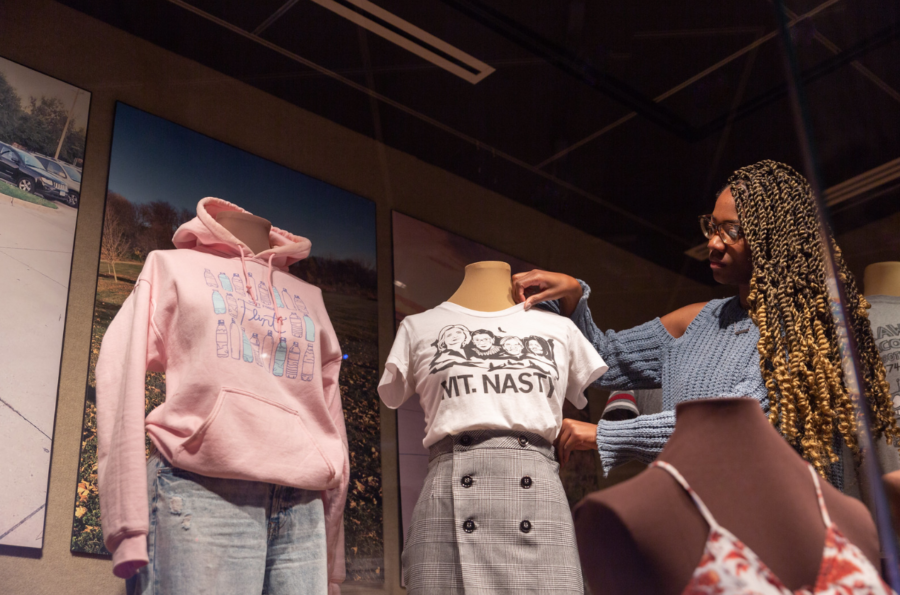First Feminist Friday focuses on how clothing can be used to make a statement
September 4, 2020
The Margaret Sloss Center for Women and Gender Equity kicked off its fall semester of Feminist Fridays with a presentation on Black women’s fashion and expression.
The presentation, held virtually on Friday at 1 p.m., featured Dyese Matthews, an Iowa State 2020 alumna in the apparel, merchandising and design program, and Kelly Reddy-Best, an associate professor in apparel, merchandising and design and the new director and curator of the Iowa State Textiles and Design Museum.
Matthews started off the presentation by introducing her exhibition that was featured in the Iowa State Textiles and Design Museum this spring titled Collegiate Fashion and Activism: Black Women’s Styles on the College Campus. Matthews noted that the exhibition was a part of her masters thesis research project.
“So the way that we can understand dress and appearance is a form of expression sometimes that people can use to negotiate their many identities or to make political statements,” Matthews said.
Matthews then referenced the definition of soul style by Dr. Ford, a fashionable expression of Blackness or to visibly identify with the Civil Rights Era, that she focused on while curating the exhibition.
She then gave examples of people using their dress and appearance to make a statement about their Blackness and activism throughout history. The examples included: the Black Panther Party who frequently wore all black ensembles paired with afros and black power image pins in the 1960s, a Gap commercial of LL Cool J wearing a For Us, By Us (a Black clothing company) hat in the 1990s and finally, an image of a Black woman wearing an “I Can’t Breathe” sweater at a Justice for All rally in 2014.
“The purpose of the research was to examine how Black women use dress and appearance practices as a way to negotiate their Black identity and/or interest in activism,” Matthews said. “And we focused on a particular space and time, being campus life at predominantly white institutions in Iowa during the Black Lives Matter Era.”
Matthews then gave a quick rundown of the exhibition, including how 40 pieces of clothing or accessories that were loaned by Black women were displayed in the public Textiles and Clothing Museum at Iowa State from Feb. 10 to Apr. 17. Due to the early close of Iowa State last spring, the exhibition’s catalog remained online.
“The methodology for the study, what I did was, I used purposive sampling of 15 participants,” Matthews said. “Each participant completed a demographic survey. I then conducted a photo elicitation with the participants, and we did in-depth wardrobe interviews.”
After analyzing the garments, Matthews and Reddy-Best organized them into different categories:
-
90s Throwback- based on 90s sitcoms where Black characters often wore brightly colored clothing with geometric shapes
-
Matriarch- featured pieces that reminded the participants of their family member and the lessons that they taught
-
Self-Created Expression- which featured handmade or painted clothing that expressed the participants’ individual style
-
Pride in Skin Tone- highlighted the fact that Black women often times were brightly colored clothes to emphasize their darker skin tone
-
Connection to Roots- showed pieces of African clothing that represent a connection to ancestors
-
Fearless Expression in Everyday Wear- focused on the fact that while there many not be many Black women at certain colleges, they are still fearless in how they express themselves
-
Black Girl Accessories- featured Black staples such as hoop earrings and head wraps
-
Messages of Strength- promoted keeping dollars within Black businesses in order to strengthen the Black community
-
Powerful Words- comprised of t-shirts that featured powerful statements of activism
-
Cause Solidarity- focused on bringing awareness to many important movements and issues
-
Yes I Can!- meant to empower Black women in areas of study that are often predominantly white males
Matthews concluded her part of the presentation by again emphasizing the purpose of the exhibition.
“In conclusion, we focused on Black women’s everyday dress and their use of clothing and its connection to Black student empowerment on the college campus, both historically and today…arguably, these women are the modern day soul sister,” said Matthews.
The presentation was then handed over to Reddy-Best to talk about her new role as director and curator at the Textiles and Clothing Museum.
During Reddy-Best’s presentation, she focused on the question, “how do we embed structural change into these institutions [the Textiles and Clothing Museum]?”
To combat this important issue, Reddy-Best detailed how she will enact structural change by rewriting the Textile and Clothing Museum’s mission statement. Reddy-Best and a team of students will analyze and gather information from other textile and clothing mission statements around the country and study social justice philosophies and literature, which will allow them to center their new statement around these philosophies.
“Once we think through our mission statement and our guiding values, then we want to think through our different policies and look through ways that are tangible, concrete ways that we can make change in the [Textile and Clothing] museum,” said Reddy-Best.
Reddy-Best then outlined changes that would take place in the Textile and Clothing Museum, such as who and where the clothing is gathered from, the shapes and colors of mannequins, and highlighting and uplifting marginalized communities.
Next week’s Feminist Friday will focus on introducing the Sloss Center and its staff.

















